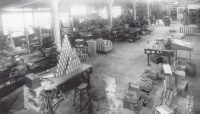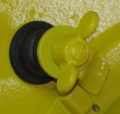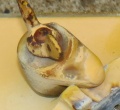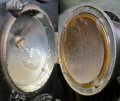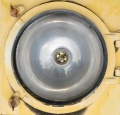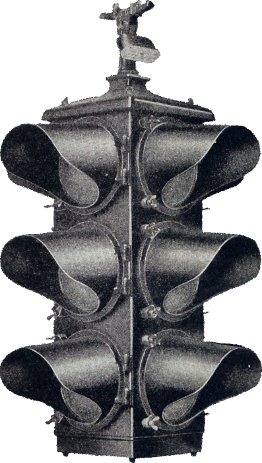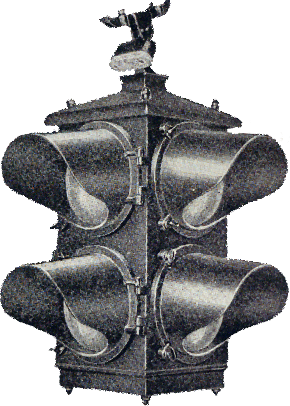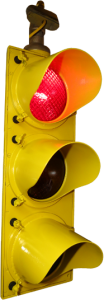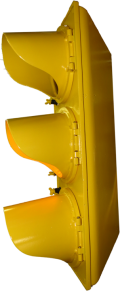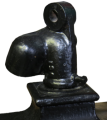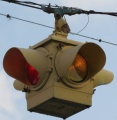Difference between revisions of "American Crucible"
(→Hardware) |
(→Corporate History and Overview) |
||
| (35 intermediate revisions by 2 users not shown) | |||
| Line 1: | Line 1: | ||
| + | [[File:Work_In_Progress.png]] | ||
| + | <br> | ||
| + | <br> | ||
| + | <br> | ||
| + | <br> | ||
[[File:AmCr_Logo_LC.png]] | [[File:AmCr_Logo_LC.png]] | ||
| Line 5: | Line 10: | ||
== Corporate History and Overview == | == Corporate History and Overview == | ||
<div style="overflow: hidden"> | <div style="overflow: hidden"> | ||
| + | [[File:AmCr_Ext_LC.jpg|200px|thumb|right|September 2013 view of the factory. Google Image.]] | ||
[[File:AmCr_Int_LC.jpg|200px|thumb|right|Undated photo of the American Crucible Products company in operation. Black River Historical Society]] | [[File:AmCr_Int_LC.jpg|200px|thumb|right|Undated photo of the American Crucible Products company in operation. Black River Historical Society]] | ||
| − | |||
| − | The American Crucible Products Company was formed in 1919. In | + | The American Crucible Products Company was formed in 1919. In 1924 it began manufacturing traffic signals and flashing beacons from the foundry in Elyria, Ohio before moving ten miles north and closer to the lakeshore of Lorain in 1926. This foundry and machine shop would remain open until 2015, the aluminum foundry closing in 1997 when focus shifted towards bronze bearings. The Lorain factory façade as seen in the image here was completely levelled by fire on March 12, 2022. |
| + | |||
| + | |||
| + | Their signal line was called '''The Master Signal'''. In 1939 a company called The Master Equipment Corp. was selling "Master" traffic lights and controllers. This link is still being investigated. At some point prior to WWII American Crucible stopped manufacturing traffic lights but are still operating today as part of BecoTek Mfg. U.S.A. Inc. They had a strong sales presence throughout Ohio including special installations in Bellevue, Dover, Hamilton, Salem, and Xenia. They had a smaller showing throughout the midwest but still had signals in Scranton, PA. and Muncie, In. Less notable installations were made in Ashland, Bedford, Bluffton, and Gallion, Ohio. They are also believed to have installations in Southern Michigan. | ||
| + | |||
| + | === Distributors and Contract Manufacturing === | ||
| + | The following companies had distribution rights to these signals or sold a private label version of the Master Signal. | ||
| + | * [[Boyd Traffic Control Corp.]] | ||
| + | * [[The Master Equipment Corp.]] | ||
| + | * [[The Prospect Fire Engine Company]] | ||
</div> | </div> | ||
| Line 15: | Line 29: | ||
The traffic signals they produced were robust and had several notable design characteristics. | The traffic signals they produced were robust and had several notable design characteristics. | ||
*Were said to have a sun phantom proof design. | *Were said to have a sun phantom proof design. | ||
| − | * | + | *The prototype models had a mirror reflector before the early production units changed to an angled bulb mount while later ones had the industry standard straight bulb configuration. |
| − | *Metal reflectors heavily chromium plated. Signals taken out of service 80 years later still have bright reflectors. | + | **Metal reflectors heavily chromium plated. Signals taken out of service 80 years later still have bright reflectors. |
| − | * | + | *Early Models used Jefferson and Brilliant orange peel type lenses (Darley-like except a blue instead of green "green" lens.) |
| + | **Later, Kopp #27 and Corning Type E | ||
*Sealed, "dustproof" construction with lens and door gaskets. | *Sealed, "dustproof" construction with lens and door gaskets. | ||
*Early models featured cast cap visors, later signals were available with cast tunnel/circle visors and removable rolled aluminum visors. | *Early models featured cast cap visors, later signals were available with cast tunnel/circle visors and removable rolled aluminum visors. | ||
| Line 25: | Line 40: | ||
*Early signals were built from single piece side plates, later versions used used a stackable design to allow easy configuration of 1-4 signal sections. | *Early signals were built from single piece side plates, later versions used used a stackable design to allow easy configuration of 1-4 signal sections. | ||
| − | There | + | There was different, early design of traffic light that was marketed in the mid 1920's timeframe. The body was slightly different with bolt on hinge plates and visors, as well the reflectors were glass. Most all the known documentation and specimens are indicative of the lights as seen from the 1930's to 1940's. The information contained in this article as of publishing time represents this single series of known lights produced. |
===Door Variations=== | ===Door Variations=== | ||
During the course of production the most marked change to the signal was the branding as presented on the door. | During the course of production the most marked change to the signal was the branding as presented on the door. | ||
| − | *Sectional body/removable cast visors [ | + | *Sectional body/removable cast visors [1924 through 1927]: The Traffic Master Co Elyria O |
| − | *The earliest | + | *Sectional body/removable cast visors [1924 through 1927]: The Traffic Mas er Co Elyria O [Note the no T in Master defect] |
| + | *The earliest improved version [1928-1930?] were of a solid body/cast visor design with no markings present on the door. | ||
*Solid body/cast visor design with: THE MASTER SIGNAL THE AMERICAN CRUCIBLE PRODUCTS CO. LORAIN O. U.S.A. | *Solid body/cast visor design with: THE MASTER SIGNAL THE AMERICAN CRUCIBLE PRODUCTS CO. LORAIN O. U.S.A. | ||
| + | *Solid body/cast visor design with: THE MASTER SIGNAL THE PROSPECT FIRE ENGINE CO PROSPECT O. ''[Verify Correct Wording]'' | ||
*Cast visor sectional body style: THE MASTER SIGNAL U.S.A. | *Cast visor sectional body style: THE MASTER SIGNAL U.S.A. | ||
| − | *Sectional body/removable rolled visor design with no markings present on the door. | + | *Sectional body/removable rolled visor design [Final Production?] with no markings present on the door. |
| − | |||
| + | ===Latch Variations=== | ||
<div style="overflow: hidden"> | <div style="overflow: hidden"> | ||
| − | |||
| − | |||
During the course of production the latching materials used to hold the door closed changed slightly. | During the course of production the latching materials used to hold the door closed changed slightly. | ||
*Most common is the stud with spring, cast tab, and steel wingnut (which often rusted and froze.) | *Most common is the stud with spring, cast tab, and steel wingnut (which often rusted and froze.) | ||
| Line 46: | Line 61: | ||
File:AmCr_Latch_LC.jpg|Stamped/Boot Style | File:AmCr_Latch_LC.jpg|Stamped/Boot Style | ||
File:AmCr_Latch2_LC.jpg|Most Common Spring/Cast Style | File:AmCr_Latch2_LC.jpg|Most Common Spring/Cast Style | ||
| + | </gallery> | ||
| + | </div> | ||
| + | |||
| + | ===Reflector Variations=== | ||
| + | <div style="overflow: hidden"> | ||
| + | There were three major styles of bulb reflector in these signals. The first style was a mirrored glass used until 1927. The second and third styles were a polished metal bowl used for the remaining period of production. From 1928 they used an offset socket in the reflector with a brass house-lamp style socket. Sometime late in production, by the time rolled visors were introduced they used a typical straight-bulb design with a two-piece porcelain socket. | ||
| + | <gallery mode="nolines"> | ||
| + | File:AmCr_Angbulbin_LC.jpg|1928-? Angled Bulb | ||
| + | File:AmCr_Strtbulb_LC.jpg|Late Model Straight Bulb | ||
</gallery> | </gallery> | ||
</div> | </div> | ||
=== Four Ways === | === Four Ways === | ||
| − | + | ||
| + | ===Early Model (1924-1927)=== | ||
| + | <div style="overflow: hidden"> | ||
| + | [[File:AmCr_Hybrid_LC.png|200px|thumb|left|Early solid-body signal with 1928 style green section added on. Note the bolted hinge plates on the red and amber as well as the slightly different design on the top and bottom plates. The visors for the red and amber section are bolt-on cast visors. The post mount may be a city-made modification, note the ball finial.]] | ||
| + | </div> | ||
====Model S-3-29==== | ====Model S-3-29==== | ||
| Line 61: | Line 89: | ||
<div style="overflow: hidden"> | <div style="overflow: hidden"> | ||
| + | |||
=== Adjustables === | === Adjustables === | ||
They also produced adjustable traffic lights. Examples of rigid body construction are known, it is not believed that they produced sectional adjustable lights. | They also produced adjustable traffic lights. Examples of rigid body construction are known, it is not believed that they produced sectional adjustable lights. | ||
| Line 96: | Line 125: | ||
The earlier lights used orange peel lenses, like used in Darley lights, except the green aspect was a blue lens, instead of a green lens. These were typically made by Jefferson or Brilliant. | The earlier lights used orange peel lenses, like used in Darley lights, except the green aspect was a blue lens, instead of a green lens. These were typically made by Jefferson or Brilliant. | ||
| − | Later lights used Corning Type-E Large Bead lenses. | + | Later lights used Kopp #27 and Corning Type-E Large Bead lenses. |
=== Pedestrian === | === Pedestrian === | ||
| Line 135: | Line 164: | ||
<gallery mode="nolines"> | <gallery mode="nolines"> | ||
File:AmCr_Ctrlr_LC.jpg|Deep Bottom for Integrated Controller | File:AmCr_Ctrlr_LC.jpg|Deep Bottom for Integrated Controller | ||
| − | File:AmCr_Hanger_LC.png|Standard Weatherhead Hanger | + | File:AmCr_Hanger_LC.png|Standard Weatherhead Hanger, Typically Brass |
</gallery> | </gallery> | ||
</div> | </div> | ||
== Miscellaneous Images == | == Miscellaneous Images == | ||
| − | + | <div style="overflow: hidden"> | |
| − | + | <gallery mode="nolines"> | |
| + | File:AmCr_Huntsv_LC.jpg|Circa August 14, 2012 this signal was still operating in Huntsville, Ohio albeit with a mismatched red-amber LED conversion. Photo by LC. | ||
| + | </gallery> | ||
| + | </div> | ||
== Relevant Patents == | == Relevant Patents == | ||
| Line 150: | Line 182: | ||
*Lorain - Images of America: Ohio, Black River Historical Society, Arcadia Publishing, 1999, ISBN 0738501786, ISBN 9780738501789 | *Lorain - Images of America: Ohio, Black River Historical Society, Arcadia Publishing, 1999, ISBN 0738501786, ISBN 9780738501789 | ||
*Google Map Imagery, September 2013 | *Google Map Imagery, September 2013 | ||
| − | |||
| − | |||
| − | |||
| − | |||
| − | |||
| − | |||
| − | |||
| − | |||
| − | |||
| − | |||
| − | |||
| − | |||
| − | |||
| − | |||
| − | |||
| − | |||
| − | |||
| − | |||
| − | |||
| − | |||
| − | |||
| − | |||
| − | |||
| − | |||
| − | |||
| − | |||
| − | |||
| − | |||
| − | |||
| − | |||
| − | |||
| − | |||
| − | |||
| − | |||
| − | |||
| − | |||
| − | |||
| − | |||
| − | |||
| − | |||
Latest revision as of 19:20, 20 April 2024
Contents
Corporate History and Overview
Traffic Signals
Design Characteristics
The traffic signals they produced were robust and had several notable design characteristics.
- Were said to have a sun phantom proof design.
- The prototype models had a mirror reflector before the early production units changed to an angled bulb mount while later ones had the industry standard straight bulb configuration.
- Metal reflectors heavily chromium plated. Signals taken out of service 80 years later still have bright reflectors.
- Early Models used Jefferson and Brilliant orange peel type lenses (Darley-like except a blue instead of green "green" lens.)
- Later, Kopp #27 and Corning Type E
- Sealed, "dustproof" construction with lens and door gaskets.
- Early models featured cast cap visors, later signals were available with cast tunnel/circle visors and removable rolled aluminum visors.
- Signals with removable cast visors are the final version produced by the Traffic Master Company or The Master Equipment Corp. around 1939 in Amherst, Ohio.
- Marketed as "light weight" and weatherproof.
- Lights with a thin bottom plate were controlled externally, lights with a large bottom section had an integrated controller.
- Early signals were built from single piece side plates, later versions used used a stackable design to allow easy configuration of 1-4 signal sections.
There was different, early design of traffic light that was marketed in the mid 1920's timeframe. The body was slightly different with bolt on hinge plates and visors, as well the reflectors were glass. Most all the known documentation and specimens are indicative of the lights as seen from the 1930's to 1940's. The information contained in this article as of publishing time represents this single series of known lights produced.
Door Variations
During the course of production the most marked change to the signal was the branding as presented on the door.
- Sectional body/removable cast visors [1924 through 1927]: The Traffic Master Co Elyria O
- Sectional body/removable cast visors [1924 through 1927]: The Traffic Mas er Co Elyria O [Note the no T in Master defect]
- The earliest improved version [1928-1930?] were of a solid body/cast visor design with no markings present on the door.
- Solid body/cast visor design with: THE MASTER SIGNAL THE AMERICAN CRUCIBLE PRODUCTS CO. LORAIN O. U.S.A.
- Solid body/cast visor design with: THE MASTER SIGNAL THE PROSPECT FIRE ENGINE CO PROSPECT O. [Verify Correct Wording]
- Cast visor sectional body style: THE MASTER SIGNAL U.S.A.
- Sectional body/removable rolled visor design [Final Production?] with no markings present on the door.
Latch Variations
Reflector Variations
Four Ways
Early Model (1924-1927)
Model S-3-29
Model S-2-29
This is the presumed model number for this variant.
Pedestrian Signals
describe models, variations
Vehicle Heads (Round)
describe models, variations
Vehicle Heads (Square Door Adapters)
describe models, variations
Pedestrian/Sign Heads (Rectangular)
describe models, variations
Informational Signals and Signs
describe models, variations [delete] includes "box signs," "case signs," and Ped Heads with special [non-ped] lenses.
Lenses
describe models, variations
Vehicular
The earlier lights used orange peel lenses, like used in Darley lights, except the green aspect was a blue lens, instead of a green lens. These were typically made by Jefferson or Brilliant.
Later lights used Kopp #27 and Corning Type-E Large Bead lenses.
Pedestrian
describe models, variations
Worded
describe models, variations
Symbols
describe models, variations
Special
describe models, variations
Controllers
- Split amber operation - only the green light traffic sees the amber.
- Single cam, induction motor mechanical controllers.
- Sealed gear system.
- Tungsten contacts with a sliding self cleaning action for longer life.
- Unique RED-I-FLASH system where a flashing red light above green indicates a signal change for two color signals.
- Single wire, impulse controlled coordination system.
- Masterless coordination system, any controller serves as master.
- Self lubricating bronze bearings.
- Positive starting in cold temperatures
Special Features Available:
- Emergency Control
- Manual Control
- Flashing or Night Amber mode
- Pedestrian Controls
- Coordination for Two and Three Period Controls
Hardware
Miscellaneous Images
Relevant Patents
Patent numbers relevant to this MFR or signals specifically. Not just every patent by company X.
References
- Lorain - Images of America: Ohio, Black River Historical Society, Arcadia Publishing, 1999, ISBN 0738501786, ISBN 9780738501789
- Google Map Imagery, September 2013



